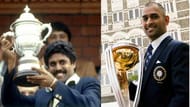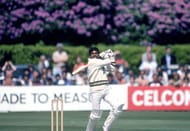1983: The World Cup that left an indelible mark in Indian cricket historyIt was a spring of despair that turned into a summer of hope. The unexpected show of strength at the 1983 World Cup proved that there was some light at the end of the tunnel after the miserable tours of Pakistan and West Indies, and helped begin a new era in Indian cricket, changing the perception of the shorter format of the game. It was the World Cup that began a national obsession.ODI cricket came to the forefront as it suited India’s style of playing and was celebrated by the masses, slowly became the force majeure format sidelining Test cricket. Before the World Cup in 1983, India had the reputation of a team that would perform badly, not because of a lack of passion for the game or incapable players, but due to its appalling squad selection. The 1983 World Cup squad was more balanced than the previous two editions and had talented players from all over the country and not just Bombay.2011: World champions for the second timeIt was a scene straight out of a Nicholas Sparks novel – tears of joy rolling down the faces of grown men and emotional players screaming and jumping with joy, for what was the defining moment of their lives. It was a moment that touched billions of hearts, with Harbhajan Singh crying on the field, Sachin Tendulkar running out with a broad smile and Yuvraj Singh screaming in joy and celebration.India were the pre-tournament favourites, but no host nation had won the World Cup final on its own soil before. It was also special because, in more ways than one, it was payback as it was Sri Lanka who eliminated India in the semi-finals of the 1996 World Cup. The 2011 final was watched live by a billion people all over the world and became the most watched match in any sport. The ODI era that flourished after the 1983 World Cup had finally come a full circle. India were world champions again, but only this time as favourites and not as underdogs.Here’s a look at some similarities between the two World Cup-winning teams:
#1 Good opening pair and stable number 3
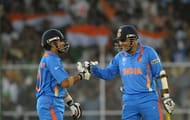
In both World Cups, India had two legends of the game opening for them – Sunil Gavaskar in 1983 and Sachin Tendulkar in 2011. Incidentally, both of them are from Mumbai which has a reputation for producing technically sound batsmen. They were accompanied on the pitch by hard-hitting men in Kris Srikanth and Virender Sehwag, who sometimes overshadowed their partners with aggressive quick-fire knocks.
Also, in 1983, the No.3 position was occupied by a ‘Delhiwallah’ who played a major role in the finals (Mohinder Amarnath) and, in 2011, Gautam Gambhir occupied that slot and carried India in the moment of crisis after the first five overs in the game that mattered the most.
Pattern: Good opening pairs with a mix of aggression and technical superiority helped India lay a strong foundation. If both of the openers failed, a stable No. 3 was there to help keep the scoreboard ticking.
Trivia: India won 4 league stage matches in both World Cups and the finals were played on a Saturday.
#2 Strong, sensible and instinctive captains
Some say that a team is only as good as its captain, and Kapil Dev and MS Dhoni are a testament to that fact. Both Dhoni and Kapil had great self-belief which empowered them to take instinctive decisions, or how else can you explain Dhoni promoting himself ahead of Yuvraj Singh in the final or Kapil going after the bowling attack in the game against Zimbabwe when India were already five men down for a meagre 17 runs. They read the game very well and acted on their instincts, which is one quality that sets them apart from the competition.
Also, their calm, sensible nature and team management skills were revered even amongst oppositions. Both captains didn’t have enough resources in the bowling department but were able to optimize and adapt according to the situation, which is quite remarkable.
Considering that Kapil didn’t have to carry the weight of expectations as confessed by the man himself, Dhoni did a wonderful job of developing a team and defined different roles in the team brilliantly.
Pattern: The thing about leadership is – either you have it or you don’t. You don’t learn it anywhere, it can’t be taught in IIMs. It’s the instincts and management of resources on the go that make you a good leader. And, a pinch of luck!
Trivia: A Bird (HD Bird) and a crow (Jeff Crowe) officiated in the finals of 1983 and 2011 World Cups respectively
#3 All-round performances come to the fore
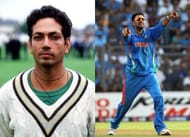
When India won the tournament in 1983, the 14-man squad had a surprise inclusion in the form of Mohinder Amarnath, who had returned from 3 years of deep slumber at the international level. He gave good performances in Pakistan and West Indies which somehow justified his addition to the squad. His performances were still considered a flash in the pan as he was never consistent. But over the course of the World Cup, we were to see some stellar performances from him – his feats in the semi-final and final were pure gold. He was the joker of the pack who had come to the circus and fooled everybody with his instinctive gameplay and amusing stroke play.
According to Yuvraj Singh, he had the worst season of his cricketing career in 10 years in 2010. What he didn’t know at the time of making this statement was that he would play the best cricket of his life in the next 6 months and get his name etched in the history books.
Pattern: Both of these players played pivotal roles in making India the world champions. They were the silent dark knights, the heroes that India deserved and took responsibility when it mattered the most (read – Yuvraj in the quarterfinals and Amarnath in the semis).
Trivia: In both World Cups, India played the semi-finals on a Wednesday
#4 Peaking at the right time
India went on to build momentum in different ways before reaching the knockout stages of the tournament.
The 1983 squad was low on confidence going into the World Cup, but had a burning desire to prove themselves and that is why the win against West Indies in the first league game was a morale booster. They proved themselves worthy of progressing to the knockouts, after two debilitating losses against West Indies and Australia, through an inspired innings by Kapil Dev against Zimbabwe and then went on to defeat Australia to move ahead to the number two slot in the group.
In the 2011 World Cup, the team was high on confidence and went from strength to strength. They were tested at every stage of the tournament, be it the England game (only the 4th tie in the history of the World Cup), or the loss against South Africa, or the horrible last five and disastrous first five overs in the final game against Sri Lanka.
After the famous innings by Kapil – where he scored 175 in 138 balls – and the virtual quarterfinal match against Australia where Madan Lal and Binny took 4 wickets apiece, it was proven that the Indian team were not to be taken lightly.
Kapil’s smile at the crease, 10 runs away from the victory in the semi-finals against England aptly epitomized the fact that his team were in with a chance to win the World Cup and somehow, almost overnight, a fickle Indian team had turned the world upside-down.
Pattern: In both the cases, the teams built momentum and progressed consequently. In a tournament which spans over two months, it is very easy to get exhausted and peak too early or get complacent and get knocked out. But as it turns out after three decades or so, we Indians decided to do things at the right time!
Trivia: Kris Srikanth, who opened the batting in 1983 World Cup, was the Indian chairman of selectors for the 2011 World Cup.
#5 Stumbling at the final hurdle and coming back strongly
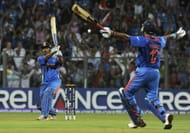
In the 1983 final, India scored a lackluster 183 and West Indies looked favorites to lift the World Cup for a third consecutive time. The same pattern was repeated in the 2011 World Cup when India bowled horribly in the last 10 overs and Sri Lanka carried that momentum to the second innings, taking out Tendulkar and Sehwag in quick succession. But the balance was quickly restored and India produced a stellar bowling performance in 1983 and a sensible batting performance in 2011, to come back strongly and lift the trophy.
Pattern: India seem to have a knack for making strong comebacks unlike the choke-o-block kids of the format, South Africa, in the World Cups. Both winning squads were able to overcome nerves and get to the finish line underlining strong team character which can be related to the quote from the movie Rocky Balboa, “It ain’t about how hard ya hit. It’s about how hard you can get hit and keep moving forward. How much you can take and keep moving forward. That’s how winning is done!”
Trivia: India finished second in the league stage in 1983 and 2011.
Click here to get India Squad for T20 World Cup 2024. Follow Sportskeeda for the T20 World Cup Schedule, Points Table, and news
